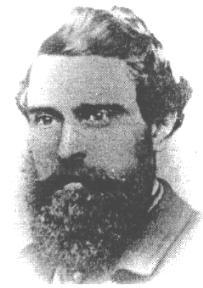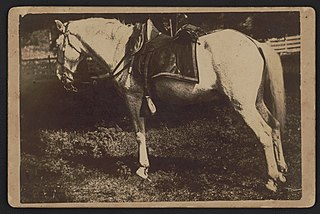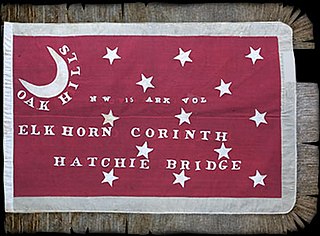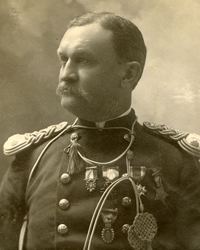
Patrick Kelly was an Irish-American Union Army officer during the American Civil War. He led the famed Irish Brigade at the Battle of Gettysburg.
The 6th Indiana Infantry Regiment was an infantry regiment from the State of Indiana that served in the Union Army during the American Civil War. This regiment was the senior Indiana regiment of the Civil War, as it was numbered first in sequence after the five Indiana volunteer regiments which had served in the Mexican–American War. The regiment was originally mustered-in for a three-month period of service between April and August 1861, but after its initial term of service had expired it was re-formed in September 1861 for a further three-year period, before being mustered out in September 1864.
The 7th Regiment Indiana Volunteer Infantry was an infantry regiment from the State of Indiana that served in the Union Army during the American Civil War.

The 7th Michigan Infantry Regiment was an infantry regiment that served in the Union Army during the American Civil War.
1st Arkansas Mounted Rifles (1861–1865) was a Confederate States Army cavalry regiment during the American Civil War. The unit was formed as a mounted infantry regiment, but was dismounted in the spring of 1862 and remained dismounted for the remainder of the war. The unit participated in the earliest battles in the western theater at Wilson's Creek and surrendered with the remnants of the Army of Tennessee in North Carolina in April 1865.

The 6th Arkansas Infantry Regiment was a regiment of the Confederate States Army during the American Civil War. Organized mainly from volunteer companies, including several prewar volunteer militia units, raised in the southern half of Arkansas, the regiment was among the first transferred to Confederate Service. It served virtually the entire war in Confederate forces east of the Mississippi River. After the unit sustained heavy casualties during the Battle of Shiloh and Bragg's Kentucky Campaign, the unit spent most of the rest of the war field consolidated with the 7th Arkansas Infantry Regiment, to form the 6th/7th Arkansas Infantry Regiment.

The 70th New York Infantry Regiment was one of five infantry regiments formed by former U.S. Congressman Daniel Sickles and established as part of the Excelsior Brigade which fought with the Union Army during multiple key engagements of the American Civil War, including the Chancellorsville, Gettysburg and Overland campaigns. Leaders from the 70th New York recruited men from New Jersey, as well as from cities and small towns across the State of New York.
Edward Jardine was an American U.S. Army officer during the American Civil War serving with the 9th New York Volunteer Infantry Regiment under General Benjamin Butler and later the Army of the Potomac under General Ambrose Burnside in Virginia and North Carolina campaigns. He was one of the senior military officers during the New York Draft Riots and narrowly escaped lynching at the hands of a mob. The injuries he sustained during the riots ended his military career.
The Thirteenth Pennsylvania Reserve Regiment, also known as the 42nd Pennsylvania Volunteer Infantry, the 1st Pennsylvania Rifles, Kane's Rifles, or simply the "Bucktails," was a volunteer infantry regiment that served in the Union Army during the American Civil War. It was a part of the famed Pennsylvania Reserve division in the Army of the Potomac for much of the early and middle parts of the war, and served in the Eastern Theater in a number of important battles, including Antietam, Fredericksburg, and Gettysburg.

The 25th Virginia Infantry Regiment was an infantry regiment raised in Virginia for service in the Confederate States Army during the American Civil War. It fought mostly with the Army of the Northwest and Army of Northern Virginia. Its soldiers saw action from the battle of Philippi until the Appomattox.
The 15th Arkansas Infantry Regiment or Josey's Arkansas Infantry Regiment was an infantry formation in the Confederate States Army during the American Civil War. The regiment was organized in May 1861 under the command of Colonel Patrick Cleburne. It served throughout the war in the western theater, seeing action in the Kentucky, Tennessee, and Georgia campaigns. Following its depletion in numbers the regiment was consolidated several times with other Arkansas regiments, finally merging in 1865 into the 1st Arkansas Consolidated Infantry Regiment. There were two other regiments which also received the designation of "15th Arkansas". The 21st (McRae's) Arkansas Infantry was redesignated 15th Arkansas in February 1863, but to avoid confusion, was normally referred to as the 15th (Northwest) Arkansas Infantry Regiment. This second "15th Arkansas" was surrendered at Vicksburg in July 1863. A third regiment, under command of Colonels Gee and later Johnson, also received the designation 15th Arkansas Infantry. This last regiment surrendered at Port Hudson, Louisiana, in July 1863.

The 6th Texas Infantry Regiment was an infantry regiment from Texas that served in the Confederate States Army in the American Civil War. The regiment fought in the Battles of Arkansas Post, Chickamauga and Missionary Ridge.

The 15th (Northwest) Arkansas Infantry Regiment (1861–1865) was a Confederate Army infantry regiment during the American Civil War. The unit was originally formed as the 3rd Arkansas Infantry Battalion. After receiving the required 10 companies, the unit was redesignated as the 21st (McRae's) Arkansas Infantry Regiment. Upon recognition that there was already a 21st Arkansas, the unit was again redesignated as the 15th Arkansas Infantry Regiment. This was the third Arkansas unit to bear the designation "15th Arkansas". The others are the 15th (Josey's) Arkansas Infantry Regiment and the 15th (Gee/Johnson) Arkansas Infantry Regiment. The unit saw action both west and east of the Mississippi, before serving in the Vicksburg campaign. The regiment was surrendered at Vicksburg in July 1863. After being paroled and exchanged, the regiment was consolidated with other depleted Arkansas regiments to form the 1st (Trans-Mississippi) Arkansas Consolidated Infantry Regiment.
The 2nd Arkansas Mounted Rifles (1861–1865) was a Confederate Army infantry regiment that served during the American Civil War. Raised in 1861, the regiment consisted of nine companies, which were drawn from various counties in Arkansas. Throughout the course of the war, the 2nd Arkansas Mounted Rifles fought in a number of battles, including those at Wilson's Creek and Pea Ridge, and participated in a number of campaigns such as Tullahoma, Atlanta and the Carolinas. The regiment's final battle came at Bentonville in March 1865 after which its remaining personnel were consolidated into the 1st Arkansas Consolidated Mounted Rifles.

The 45th New York Infantry Regiment, also known as the 5th German Rifles, was an infantry regiment that served in the Union Army during the American Civil War. It was composed almost entirely of German immigrants. Formed approximately five months after the start of hostilities, the unit's service spanned almost the entirety of the war, and it saw action in several of the war's noteworthy battles, in both the Eastern and Western Theaters.

The 61st New York Infantry Regiment, also known as the "Astor Regiment", was an infantry regiment of the Union Army during the American Civil War.

Erasmus Corwin Gilbreath was a major in the United States Army who began his 37-year career as a first lieutenant in the 20th Indiana Volunteer Regiment. Gilbreath was involved in numerous battles during the American Civil War, such as Gettysburg and bearing witness to the battle between the CSS Virginia and the USS Monitor, the American Indian Wars, in which he helped establish Fort Custer, and the Spanish–American War. Gilbreath is buried in Arlington National Cemetery with his wife, Susan, and daughter, Etta.

The 4th Pennsylvania Infantry Regiment, officially known as the 4th Regiment, Pennsylvania Volunteer Infantry, was an infantry regiment of the Union Army in the American Civil War. Formed mostly from a militia unit in Norristown in southeastern Pennsylvania, the regiment enlisted at the beginning of the American Civil War in April 1861 for a three-month period of service under the command of Colonel John F. Hartranft. Logistical difficulties bedeviled the regiment, which served as part of the garrison of Washington, D.C., until late June, when it was sent into Northern Virginia to join in the army of Brigadier General Irvin McDowell.

The 49th New York Infantry Regiment was an infantry regiment in the Union Army during the American Civil War.

The 51st New York Infantry Regiment was an infantry regiment in the Union Army during the American Civil War.











